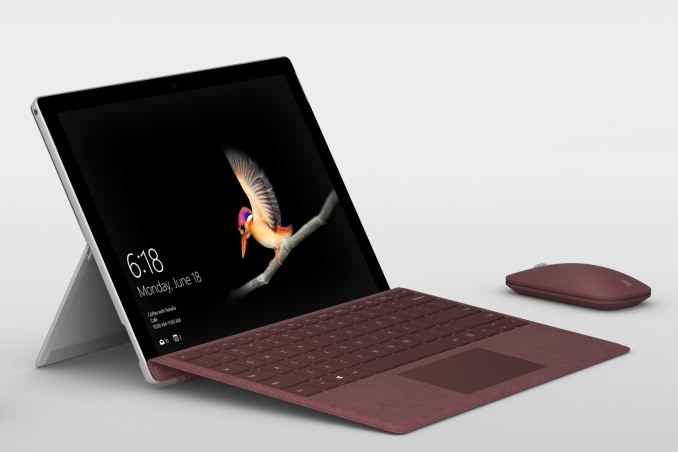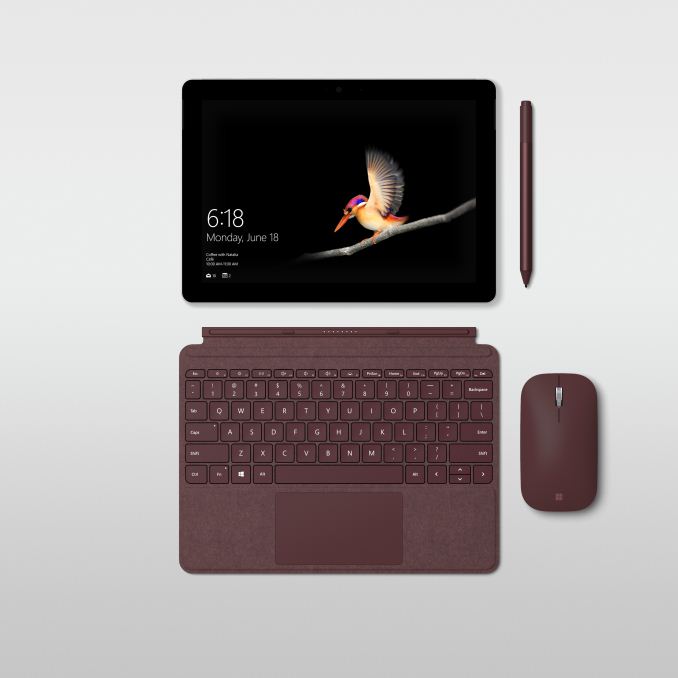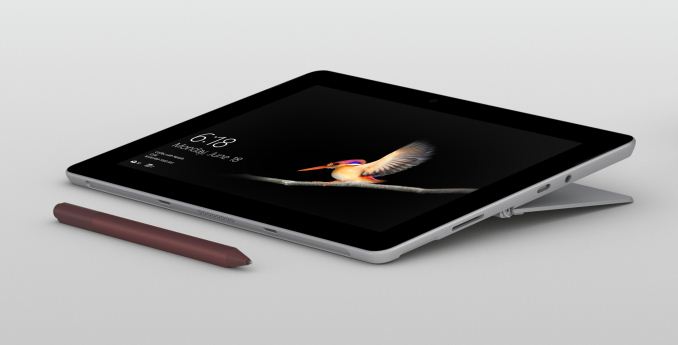Microsoft Announces The Surface Go: Smaller And Less Expensive
by Brett Howse on July 9, 2018 9:15 PM EST- Posted in
- Laptops
- Microsoft
- Surface
- Tablets
- Surface Go

Just over three years since the launch of the surprisingly good Surface 3, Microsoft has finally refreshed this category with a new device, now called the Surface Go. The Surface Pro series has been very successful for the company, and they’ve decided it’s time to offer an entry level Surface again. The Redmond company has been working on trying to win back the education market, so a smaller, lighter, and most importantly, less expensive Surface makes a lot of sense.
The Surface Go is the thinnest and lightest Surface yet at just 8.3 mm, down from the 8.7 mm of the Surface 3, and 8.5 mm on the latest Surface Pro, but it undercuts the other models on weight significantly at 521 grams, or 1.15 lbs. That’s a full 31% lighter than the larger Surface Pro.
The display is also smaller, this time coming in at 10-inches in the now familiar 3:2 aspect ratio Microsoft has focused on, and the taller aspect ratio certainly helps on mobile devices such as this that may be used in portrait. It’s an 1800x1200 PixelSense display, with 10-point multi-touch and Surface Pen support. The screen has a reasonable 216 pixels per inch of density, which is pretty much the same as the Surface 3 back in 2015 which was 213 PPI. That’s not quite as high as the Surface Pro or iPad Pro, but should still be fairly clear.
One of the biggest upgrades over the outgoing Surface 3, which was the first of the value-oriented Surface models to ship with an x86 processor, is the move from the quad-core Atom to an Intel Pentium Gold 4415Y. This is a dual-core Kaby Lake processor with four threads, and a 1.6 GHz base frequency. With a TDP of just 6W, it’s not going to be a powerhouse, but it’ll still offer solid performance for a device of this size. The low TDP also means that it can be fanless, which it is. The CPU is coupled with the Intel HD Graphics 615, which offers 24 Execution Units (EUs), although at just 850 MHz maximum boost. Still, that should offer a good jump over the Atom in the previous model.
The base model comes with just 4 GB of LPDDR3-1866, and 64 GB of eMMC storage, although it will be offered in 8 GB RAM versions with 128 GB and 256 GB NVMe SSDs, which should offer much better performance.
| Microsoft Surface Go | |||||
| Surface Go Specifications | |||||
| CPU | Intel Pentium Gold 4415Y (Kaby Lake-Y) 2 core, 4 thread, 1.6 GHz base frequency |
||||
| GPU | Intel HD 615 24 EUs 850 MHz boost frequency |
||||
| Display | 10-inch PixelSense 1800x1200 3:2 aspect 216 Pixels Per Inch 10-point Multitouch Surface Pen support |
||||
| Dimensions | 245 x 175 x 8.3 mm 9.6 x 6.9 x 0.33 inches |
||||
| RAM | 4 or 8 GB LPDDR3-1866 | ||||
| Storage | 64 GB eMMC 128 / 256 GB NVMe SSD optional |
||||
| Wireless | 802.11ac with Bluetooth 4.1 Qualcomm Snapdragon X16 LTE Optional |
||||
| Battery | Up to 9 hours of video playback 24W Charger |
||||
| Cameras | Windows Hello IR camera 5 MP Front Camera with 1080p video 8 MP Rear Camera with 1080p video |
||||
| Ports | USB Type-C 3.1 Gen 1 with power delivery Surface Connect MicroSD Headset |
||||
| Price | 4GB/64GB $399 8GB/128GB $549 Windows 10 Pro $50 extra |
||||
The Surface 3 was charged with micro USB, but the Surface Go steps up to the 24-Watt magnetic Surface Connect found on the rest of the mobile Surface lineup, and it also includes a USB 3.1 Gen 1 with a Type C connector, and they’ve kept the expandable storage with MicroSD included.
Microsoft has also included an IR camera for Windows Hello login, along with a 5 MP front camera for 1080p video, and an 8 MP rear camera. For those that want to use it on the go (pun intended) there will be an LTE model available too, which makes sense with Microsoft’s push towards Always Connected PCs.
Microsoft is claiming up to 9 hours of battery life which they tested doing video playback on the top end model.
Microsoft is also launching a new Surface Type Cover for the smaller model, featuring the same Alcantara as its larger siblings, or as just black if you prefer that. Microsoft has also found a way to fit their full-friction hinge to the smaller Surface Go, allowing for up to 165° of movement.
The new low-end Surface Go looks like a great replacement for the Surface 3, offering a way into the Surface lineup at a much more affordable price. The move to Kaby Lake will be a major boon to performance as well. Prices start at $399 for the base model, $449 for the same model with Windows 10 Pro, or $549 for 8 GB of RAM and 128 GB SSD. The 256 GB and LTE models will ship later. Pre-orders should be available soon.
Source: Microsoft













111 Comments
View All Comments
SaolDan - Tuesday, July 10, 2018 - link
Thats a U series. The Surface go uses Y series.arashi - Tuesday, July 10, 2018 - link
To be fair IU2K posted "2.7GHz Goldmont Plus is quite comparable to 2.2GHz Skylake.", Which is close enough to 2.3GHz of the U series.If you scale it to 1.6GHz it's only about ~5% behind in multicore.
Namisecond - Tuesday, July 24, 2018 - link
It sounds comparable to me.1173 vs 1317 in single core. That's like what, 11-12% difference? And that's with higher variability and lower average score on the N5000.
Eris_Floralia - Tuesday, July 10, 2018 - link
A dual core 2.7Ghz GLM+ scores around 150cb in Cinebench, which is only comparable to a single Skylake core at 3.6Ghz.0iron - Tuesday, July 10, 2018 - link
Compare to core m3-6Y30, how does this one fares?ViperV990 - Monday, July 9, 2018 - link
Looks like there's no TurboBoost for the CPU, so does that mean it will never go beyond 1.6GHz?IntelUser2000 - Monday, July 9, 2018 - link
No, that's why the Gemini-lake based N5000 will be significantly faster, even though Goldmont Plus is slower per clock.The GPU is 50-80% better, so there's that. I guess they figured the CPU is enough for the trade-off they had to make.
hyno111 - Tuesday, July 10, 2018 - link
Maybe its because N5000 does not support LPDDR3. Or marketing concern (Atom etc. despite N5000 is faster even in single core performance)There are benchmarks for 4410Y, which is basically a 1.5Ghz version of 4415Y (as suggested by ark).
IntelUser2000 - Tuesday, July 10, 2018 - link
N5000 supports LPDDR4, which is even better than LPDDR3.It seems Intel is very much downplaying the new cores. It almost feels like internal conflict since the "little" cores have been making steady and large progress over the years while the main team has been standstill since 2015.
Kan9al - Tuesday, July 10, 2018 - link
Stop preaching the N5000... it's not Intel's best solution for tablets.The Core i3-7y30 (m) is still faster (30-50%) in the single-core performance. And although it only has x2 cores hyperthreaded, its still faster (1-10%) than the Atom's x4 cores no-hyperthreaded. I'm basing this off CineBench r15, which is an excellent benchmark that gives an idea of practical real-world performance not something dodgy like Geekbench.
Although I agree with you, the Pentium 4415y is not a good SoC, because it has been artificially handicapped by Intel to stay at a measly 1.6GHz. This processor really isn't much different to the Core M chipsets that can handily push over 3GHz.
So yeah, N5000 for PC/Tablets that cost <$500... Dualcore Core i-U's for $500-$1,000.... and Quad/Hexacore Core-i chips for >$1,000 should be the norm. Intel doesn't want to do that, but Ryzen is going to force their hand, and I as a consumer cannot wait.